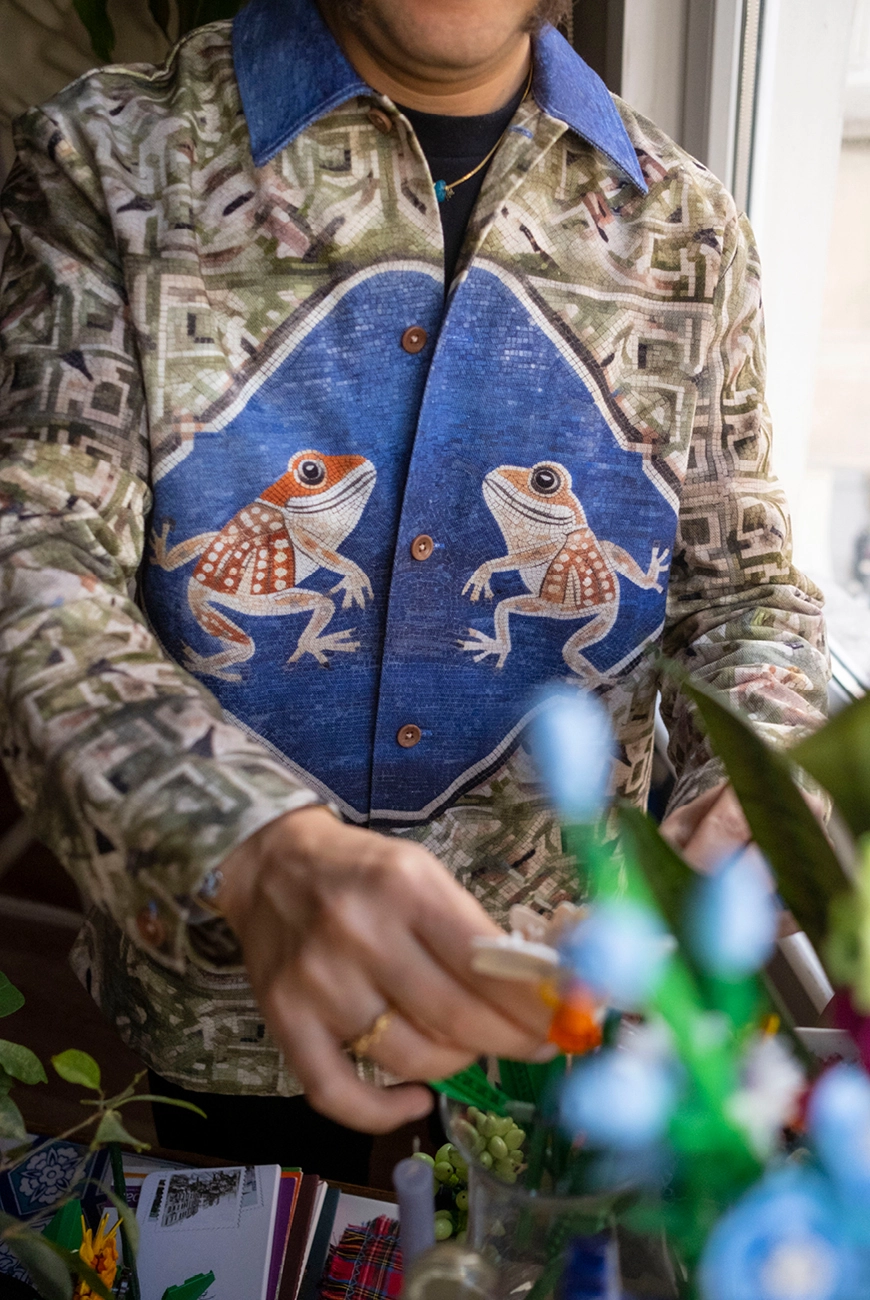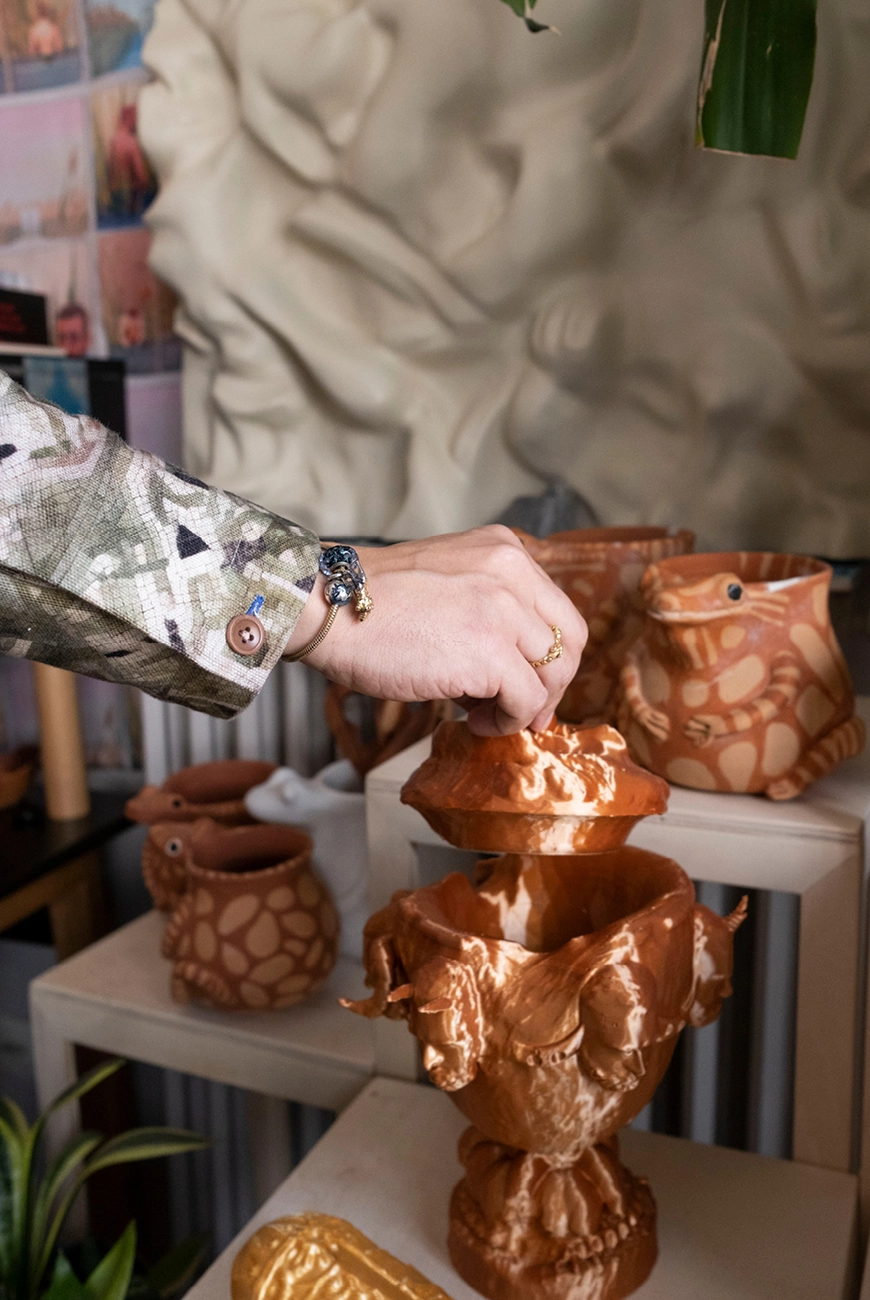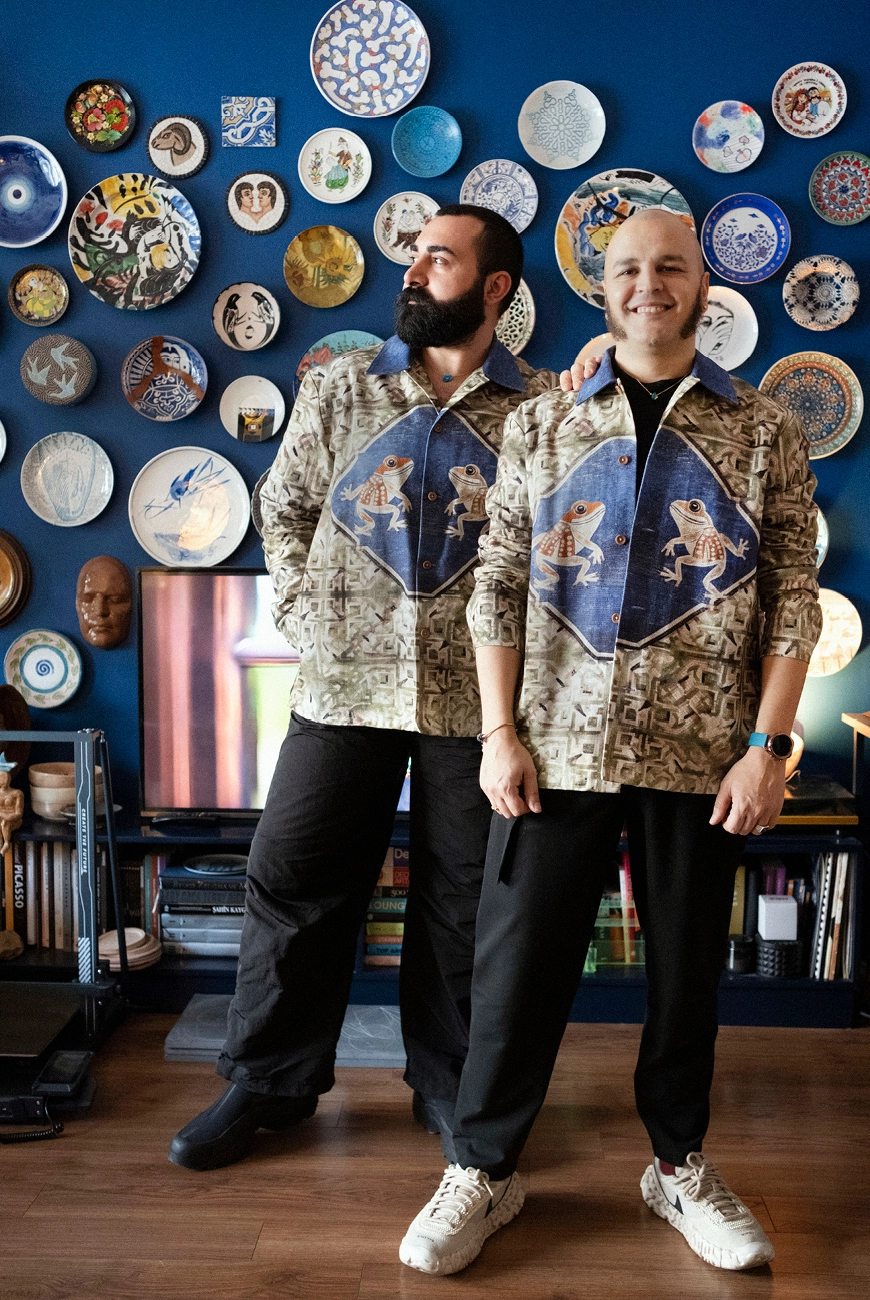
In our conversation with Ahmet Rüstem Ekici and Hakan Sorar, we discussed their first joint exhibitions hosted by Bilsart, as well as our collaboration.
Photos: Elif Kahveci (@elifkahveci)
1. Hi Ahmet and Hakan! First, would you like to tell us a bit about yourselves? What kind of education have you received, where do you live and work? What are you currently spending most of your time on?
Ahmet Rüstem specialized in stage design after studying Interior Architecture and Environmental Design at Bilkent University’s Faculty of Fine Arts. As for me, I pursued Communication Design and Semiotics at the Faculty of Art and Design after completing my degree in Mechanical Engineering. We have been living and creating together for seven years. In our work, we often focus on the relationships between textures, patterns, the body, and architecture, drawing great inspiration from the storytelling and knowledge transfer abilities of archaeological objects and surfaces. Pursuing innovation is very exciting for us, and exploring new-generation technologies and finding the most suitable production techniques and materials for our work makes our process more efficient. Especially over the past three years, experimenting with artificial intelligence tools, working on machinima, and learning about the potentials of game engines have been particularly exciting for us.



2. Hakan, you held your first solo exhibition in 2020. What was the experience like for you? What followed afterward?
I was fascinated by films like Polaroid/Fujifilm Instax, which could create images with their own aesthetics, lighting conditions, and clarity without needing editing. It was during this time that instant film printers emerged, allowing us to direct films that we thought portrayed this reality as accurately as possible. Thus, I was able to print images created with highly realistic virtual bodies and textures onto these films. In 2020, I was working on the potentials of instant films and on capturing memories and processes within a frame. With new-generation tools, I created series that emphasized the changing nature of reality, even in instant films like Polaroid/Fujifilm Instax, underscoring the distinctions between virtual and real through our perception of reality. I was pondering heavily on the word “ambiguous.” During that time, I virtually exhibited the “Through The Skin” series, focusing on the body, due to the pandemic. Designed by Ahmet Rüstem, this VR space was one of the first virtual exhibitions of the pandemic. The interaction of an exhibition with approximately 20,000 visitors, transcending the boundaries of time and space, greatly impressed me. Following that, we continued to experiment with virtual reality and augmented reality. Now, I’m exploring the same questions with artificial intelligence image generation tools.



3. Ahmet, you worked in art direction for television stage design for 15 years. What was the experience like for you?
Set design offers a world filled with visual experiences transmitted from the camera lens to screens, adorned with illusions, and television studio design is a particularly enjoyable discipline. We continue to experience spaces and forms according to camera angles, even through virtual cameras in 3D visualization programs. This discipline has made me quite adept at determining themes and subjects suitable for form, texture, and lighting. Experiencing a design I created in a 3D environment on a large scale within a space and then experiencing its transformation and evolution with light was a wonderful feeling. This industry introduced me to LED screens, lighting and directing techniques, optical illusions, and virtual studios as early as 2008. Therefore, I was fortunate to experience both the development of 3D visualization programs and to explore their potentials. In short, experiencing today’s VR/XR experiences through tools and our phone cameras strengthens the connection I establish in my works.
4. Have there been any moments from your exhibitions or stages that have challenged you in a different way or that you will always remember?
Our exhibitions have taken shape with narratives that we could impart to the masses, conveying the information we want to pass on to the future or adding parallels to our reflections on the past. Therefore, we found our virtual exhibitions, where we met with communities beyond galleries, to be very valuable. Creating LED screen videos for Kalben’s album “Kalben’s Fire of the Ancient World,” accompanying her lyrics and music on tours for thousands of audiences, and telling visual stories were very precious to us.
5. In Bilsart and Monoco, you held your first joint exhibition titled “Rest in Pieces.” The starting point of this exhibition, inspired by the breeding journey of frogs, is the frog-shaped ritons believed to have been made about 5000 years ago and exhibited in the Kütahya Museum. What was it like to share and explain this exhibition with visitors?
We find it very valuable to examine the stories on the surfaces of most of what are now defined as archaeological objects, once everyday objects, which transfer information about their eras, geographies, and transitions between cultures, and we appreciate working with scholars, archaeologists to convey our works to the future with new-generation technologies. More than 60 people contributed to this exhibition. Throughout the process, we built our own fictional museum by engaging in close dialogue with architects, archaeologists, artisans, and art writers, discussing the journey of frogs in the Domaniç region and the possible inspirations for humanity 5000 years ago. It was very valuable for visitors to meet this marginalized species, encounter a form that emerged in Anatolian lands, and experience the forms that artificial intelligence and images can transform into. We are fortunate that it was shown in many sources as one of the exhibition selections of the year and reached a large number of visitors. We would like to thank everyone who participated in tours and art talks, experiencing and making visible the journey of frogs.
6. Concurrent with the exhibition, we designed the “Rest in Pieces” shirt jacket with Bil’s x Ahmet Rüstem Ekici – Hakan Sorar. What was the journey like for you to create a shirt born from imagining and producing the design?
We find it valuable to establish a connection between digital art and archaeology while focusing on concepts in archaeology. As a species, we left traces in mud, sand, and cave walls. We continued to develop our methods of leaving traces on the ground, walls, tomb surfaces, and outside a ceramic vessel. At this point, we believe there is a strong connection between digital art, which experiences pixel essences and mosaics on screens and paper, and tesserae that create mosaics. Pixels come together and form the image, telling the story. For Bils, both the frogs that were the starting point of our exhibition and the multi-dimensionality concerns of mosaic patterns and ancient mosaic masters formed the basis of our design. Augmented reality here is an important tool that brings us together with this multi-dimensionality. Thus, we can go beyond the pattern, create a new layer on the pattern and jacket, and establish a connection between what seems archaeological and what is not visible. The most enjoyable part of the production experience is when this pattern, formed layer by layer with artificial intelligence tools, meets a sustainable fabric.
7. Do you have a message for those who will wear these designs, which have only 53 editions?
The Domaniç frogs, who try to reproduce their offspring through a difficult path but even lack a traffic sign today, are always with you. We hope they will always bring you luck as pioneers who combine augmented reality with textiles in Turkey.



8. This Bil’s Shirt Jacket, created with the potentials of artificial intelligence tools that generate images from words, meets a new face with the Artivive App, taking the story to new layers. What does using artificial intelligence bring to your work?
We are in a tremendous process where our thoughts transform into words, and words into images, videos, sounds, and 3D objects. There were many technical limitations in transforming the tracks left by humans observing nature 5000 years ago into frog-shaped ritons. Image generation tools offer us as many possibilities as possible. The most advantageous aspect of these tools is speed. Thus, we can quickly create a pattern that might have taken dozens of days in the past according to our requests.
9. What topics are you currently working on? What can we expect from you in the future? Could you tell us about your future projects?
We enjoy looking at archaeology from a queer perspective and reinterpreting it. Therefore, we closely follow the publications and excavations in our country as much as possible. Rest in Pieces was a deep exhibition that will seed and germinate many topics within itself. Our next exhibition will again be shaped by the traces left by humanity and new-generation technologies. We are particularly interested in tombstones and tomb structures as forms that bring together the body and architecture. We will continue to learn and develop through various excavations throughout the summer.
10. At the end of this enjoyable interview, we thank you for taking the time for us. Finally, do you have a film, book, or song list that you’ve been following recently and would like to recommend to readers?
We find TAG Turkey publications very valuable. Especially “Identities in Archaeology” and “Archaeological Things” selections are full of valuable information that will broaden our perspectives. Recently, Ahmet Rüstem has been reading memoirs and experience writings on important points of theater/stage design such as Osman Şengezer and Metin Deniz, while I have been focusing on analyses of the Epic of Gilgamesh and writings on body/death policies by valuable figures like Ahu Antmen and Zeynep Sayın. The book “Jilet” by Jilet Sebahat, who contributed with her text to the Wet Volume exhibition at Bilsart, also took its place on our shelves. We also love experiencing the most advanced examples of CGI technologies and tracing experimental techniques and methods in cinema history that have opened up spaces for directors. Kate Bush, Annie Lennox, Marianne Faithfull, The Shangri Las, Lady Gaga, Kalben, Ayça Şen, Lykke Li, Yeni Türkü, Lana Del Rey, Ahmet Ali Arslan, Hedwig and The Angry Inch soundtracks, and many more musicians, are all our companions in different moments of our lives.
Ahmet Rüstem Ekici: @ahmetrustem
Hakan Sorar: @hakansorar